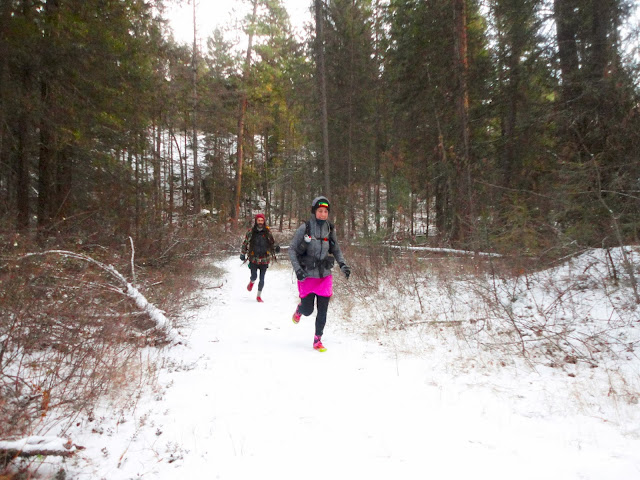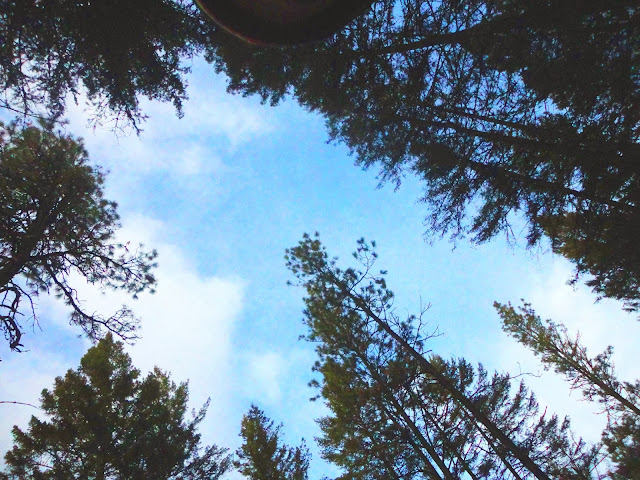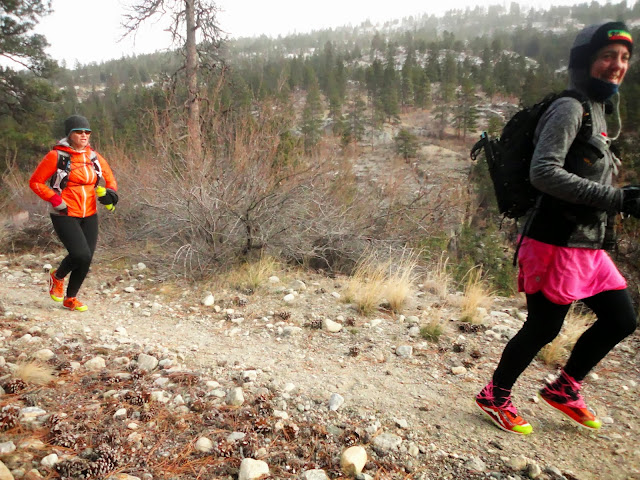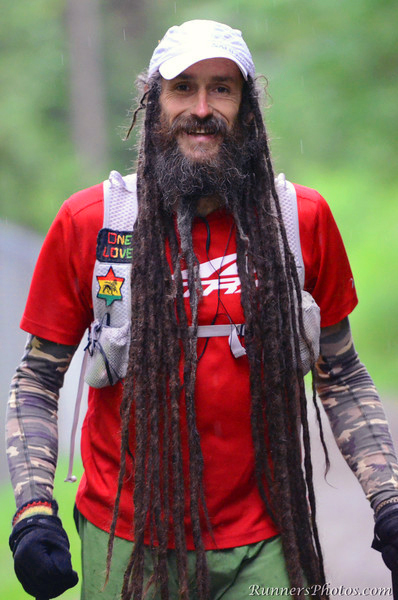It's not very often that the offer of a paid entry into a race, with a stay at the local Hyatt House afterwards comes my way, so I said "yes" as soon as the words came out of Ras' mouth. A fellow friend, ultra runner, and all around warm-hearted guy offered us this kind gift. The offer came a week before race day, but I felt ready to run a 50k; the Bridle Trails Winter Running Festival, put on by Northwest Trail Runs and the Seattle Running Club. Eric Sach of The Balanced Athlete was the race director. The start time was 3:00 p.m., which meant most of the race would be run in the dark, on trails I've never run, which have a reputation for being very muddy. The race's slogan is "I survived the mud." The forecast called for 100% chance of precipitation with wind gusts as strong as 33 m.p.h. This forecast could only make the trails live up to their reputation and the run itself more exciting. I was game.
The course was a 5.2 mile loop and had a choice of distances available: 5 miles, 10 miles, 50k relay teams or 50k solo. Ras and I would be running the 50k solo option, but we would run it together. I prefer to run with someone at night, Ras and I enjoy running together and he wanted to help pace me to a decent finishing time. In looking at the past year's race results, we could see the course was fairly fast, despite being a night time run. I hoped to finish in 7:30, which would be my second fastest 50k finishing time so far. Ras didn't have any specific expectations for himself other than to have a good time running, so he decided he would run this one with me.
When we arrived at the race start area in the Bridle Trails State Park in Kirkland, branches were breaking off of trees and scattering themselves around the parking lot. The parking volunteers were bundled up and smiling, keeping the mood positive. The wind was howling, the rain was pelting against the car and the clouds looked ominous. There were no signs of the storm lifting and yet cars were pouring into the lot. Trail runners are not the kind of people to back out because of a little storm in the area.
Around the race start, Eric was busy talking with one of the park rangers. The ranger was leaving the decision to Eric about whether or not to continue with the race in the stormy conditions. Trees breaking and falling over the trails were a big concern. Runners got checked in and got their bib numbers; visited with each other; cracked nervous jokes about how the night would play out; and any ultra runner in the crowd was secretly wishing that they were running the 5 mile distance instead.
Fellow Seven Hills Running Shop team members Matt Urbanski and Ras met each other and visited under the shelters. Ras announced that he felt like he was the guy in the Sesame Street song "One of these things is not like the others, one of these things is not the same" Joking with Matt, he said "Let's book end this thing! You take the front, I'll take the back!" Luckily, with a few ultras under my belt now, its not always a given that I will DFL (Dead F'ing Last). Since Ras was running this one with me, it was going to be up to me to make sure it didn't happen this time.
Eric postponed the race by about a half an hour as runners huddled underneath the Easy-Up shelters to stay dry, crowding as close to the propane heaters as they could get without burning tech fibers. When the smell of burnt hair wafted through the tents, Ras announced "Uh oh, I smell burnt hair. Someone just got a free Brazilian." Finally, Eric announced that the race would start in 5 minutes and that he would decide after each 5 mile loop whether or not to have runners continue. Instead of staggered starts for the different distances, he said we would all start at once. There were over 100 runners, and we lined ourselves up according to paces. Ras and I got in the back as he joked about how we would officially lead the 15 minute pace group.
The rain did not let up for us, but we all funneled onto the single track to start the mudfest that would be Bridle Trails 2014. Some of the runners at the start were timid about getting their feet wet, but finally someone hollered to them to get over it, and the pace of the lemming line picked up as it wound through the trees for the first of the loops, the only one I would run entirely with some light still in the sky. The rest were all in the dark, with city lights as a back drop, my headlamp and sternum light leading the way for hours.
I really like the way the trail was rolling and winding. It was always changing. The puddles were big and deep and the mud pits were the same. Living on the east side of the Cascades, rain and mud are seasonal and rare. Sometimes in the spring, when the snow first begins to melt down to the bare ground, mud will form. Usually, the moisture just evaporates and the mud doesn't last long. I don't have many chances to practice the art of running in the mud. I ran Chuckanut 50k 2 years ago, and the mud was tough. I've let it's memory hang over my head and thus, I've had a hang-up regarding mud. My goal was to get over it, quick, with this race and act as if I knew exactly how to handle it. I ran through it without letting it slow me down and I did not waste energy trying to avoid it when I got to the big pits. It was fun getting muddy and splashing through the puddles. I am stoked afterwards to look back on the improvements I've been able to make in running in the mud.
 |
| Mike Kuhlmann navigating the mud in the 10 miler |
He said he could help me, but I would have to do what he suggested. I needed to change my technique on the climbs and get my mind in a better place. He suggested I start counting my foot falls in threes, like a waltz, which would keep my foot turn-over up and keep my mind distracted. Ras said if I just did that and focused on good form, the rest of the race would run itself. I was willing to give it a try. "One, two three; two, two, three; three, two, three", and so on. It helped amazingly well and before I knew it, I was cruising along happily, like a waltz. When I got to hills, I took shorter steps and focused on powering up as fast as I could.
I kept sipping on my Hammer Perpetuem and snacking on Gu Chomps. I was using caffeinated products for this night time run: Cafe Latte for the Perpetuem and Blueberry for the Chomps. I didn't want to get sleepy. As it turned out, I didn't get sleepy and running in the dark was not nearly as much of an issue as I had thought it might be beforehand. The aid station was a welcome spot in the night. The 5 mile loops seemed to go by quickly. A string of Christmas lights over the trail could be spotted from a distance. They were about a mile from the aid station/start/finish area and it was always great to see them. I was usually able to pick up the pace and run well to the aid station after seeing this brightness in the dark forest. There was a nice gentle descent into the aid area; a great way to finish off each loop. Friendly volunteers filled water bottles, offered hot vegan black bean soup and gave encouraging words each time I passed through. After hitting the aid station, runners had to run a short stretch to pass over the timing mats and get to the drop bag tents. After some loops, I changed into dry layers. Most of the time, I headed out before Ras and he would catch up to me. Mentally, the loop format made the race seem easier. Five miles is a good distance to run with just one water bottle and a few snacks. Before you know it, you are back around to the welcoming cheers, lights and layers. Its not hard to head out for the next loop, knowing you'll come back around to this spot in another hour or so.
 |
| With Eric Sach, Race Director and proprietor of The Balanced Athlete |
Normally after a race, Ras and I end up camping out in a tent afterwards; going on a long, uncomfortable car ride to get back home; or staying at a relative's home, arriving dirty, cold and wet with sweat, expecting to be fed right away. After Bridle Trails, we arrived instead at a wonderful hotel, fancier than anywhere we have ever stayed. The brand new Hyatt House hotel was only a 5 minute drive away. We were able to use a cart for our bags, take an elevator and hobble down the hallway to our fancy room, getting there around midnight ready to take full advantage of the comforts. I called 1st shower, grabbed my Knudsen Grape Recharge Drink, and headed for the pristine white bathroom. I set the plastic bottle on top of the shiny toilet lid to get ready for showering and before I knew it, the purple beverage was spilling out onto the tiled floor. Every surface in this wonderful room was waxed, shiny and beveled. The drink slid off of the toilet top so fast and the lid shattered in a millisecond. The perfect setting was now a disaster area. Unable to bend over, squat down or move very effectively any more, after having just ran 31 miles, I now had to mop up a floor. I was determined to have it back to the pristine, perfect whiteness I had first laid eyes upon, before I showered. Ras brought me a roll of paper towels from the kitchenette. Twenty minutes later, I stood under the hot water and rinsed the mud, sweat and grape drink from me.
This run was an awesome experience in so many ways. I am thankful to the friend who made the whole weekend a reality. (May many blessings come your way!) I learned that I can run a 50k at a last minute notice. I learned that I actually love running in the mud when I don't see it as an obstacle to avoid on the trail. I discovered that I can run in the dark just as fast as in the daylight with good lights and confidence. And lastly, I got a taste of what this season has in store for me as I head into it as an ambassador for Altra Running. As I ran through the rainy darkness, pushing up hills and gushing through mud pits, I thought often of the Lone Peak trail shoes on my feet and the company who I feel happy to represent. Being an ambassador for them, gave me the strength and motivation I needed to push on during the low moments. The rugged tread, zero drop platform and lightweight feel of the shoes themselves helped me get through the conditions without a fall or rolled ankle. Now when I set forth on all of my trail running adventures, my accomplishments will not only speak well of what I can do and what other human beings are capable of doing, but of what a shoe company can do to make these goals a reality.
 |
| Bonaparte Mountain adventure |
 |
| Jason Llewellyn & Lisa Eversgerd |
Special thanks to Takao Suzuki of www.Runnersphotos.com for the use of his photographs.


























